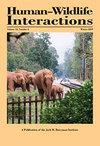用围栏加强现有的孤立地下通道,减少野生动物的碰撞,并连接栖息地
IF 0.9
4区 环境科学与生态学
Q4 BIODIVERSITY CONSERVATION
引用次数: 3
摘要
在美国,野生动物与车辆碰撞对司机和野生动物种群的影响已经引起了人们的关注。鉴于设置围栏的野生动物过境点在减少野生动物碰撞和连接栖息地方面取得的成功,交通部门需要有关成本效益的实施方法的信息。当修建野生动物通道时,它们通常被建在新的道路项目中,作为一系列2个或更多的地下通道和/或立交桥结构,由隔离围栏连接起来。鉴于交通预算有限,而且在许多州,维修活动比新建设更为普遍,因此,在以前建造的道路上加强现有地下通道已被认为是一种具有成本效益的缓解机会。然而,在现有的地下通道上增加围栏的效果还需要更多的研究,特别是那些彼此距离太远而无法与连续围栏相连的地下通道。在本研究中,我们评估了该措施应用于孤立地下通道时的有效性。在美国弗吉尼亚州64号州际公路上,两条现有的地下通道,一条是大型桥梁地下通道,另一条是大型箱形涵洞,彼此相距约8公里,每条地下通道都增加了大约1.6公里的2.4米高的野生动物围栏。我们进行了一项为期2年的围栏后相机监测研究,并比较了围栏前2年与白尾鹿(Odocoileus virginianus)和黑熊(Ursus americanus)碰撞频率的研究结果;野生动物使用地下通道;还有路边鹿的活动。我们还评估了鹿的活动数据,以比较在研究地点应用的不同围栏末端设计。设置围栏后,箱涵和桥梁下道口的车鹿碰撞(DVCs)分别降低了96.5%和88%,且围栏两端1.6 km范围内的车鹿碰撞(DVCs)没有增加。箱形涵洞的鹿口增加了410%,桥下通道增加了71%。其他哺乳动物对涵洞和桥梁地下通道的使用分别增加了81%和165%。尽管鹿对地下通道的使用远远大于它们在任何围栏末端的活动,但在围栏末端,鹿的活动相对较高,这与路权围栏等特征无关。我们的研究发现,在某些现有的孤立地下通道上增加野生动物围栏是一种极具成本效益的方法,可以提高驾驶员的安全性,增强野生动物栖息地的连通性。减少碰撞的效益在1.8年内超过了围栏成本,在围栏25年的使用寿命内,平均每个站点节省了230万美元。研究结果增加了我们利用现有基础设施连接野生动物栖息地和提高驾驶员安全的有效方法的知识体系。本文章由计算机程序翻译,如有差异,请以英文原文为准。
Enhancing Existing Isolated Underpasses with Fencing Reduces Wildlife Crashes and Connects Habitat
The impact of wildlife–vehicle collisions on drivers and wildlife populations has been gaining attention in the United States. Given the established success of wildlife crossings with fencing in reducing wildlife crashes and connecting habitat, information is needed on cost-effective means of implementation for departments of transportation. When wildlife crossings are constructed, they are often built into new road projects as a series of 2 or more underpasses and/or overpass structures connected by exclusionary fencing. Given limited transportation budgets and the prevalence of maintenance activities more so than new construction in many states, enhancing existing underpasses on previously constructed roads has been recognized as a cost-effective mitigation opportunity. More research is needed, however, on the effects of adding fencing to existing underpasses, particularly those that are too far from one another to be connected with contiguous fencing. In this study, we evaluated the effectiveness of this measure when applied to isolated underpasses. Approximately 1.6 km of 2.4-m-high wildlife fencing was added to each of 2 existing underpasses, a large bridge underpass and a large box culvert, situated approximately 8 km apart from one another on Interstate 64 in Virginia, USA. We conducted a 2-year post-fencing camera monitoring study and compared the findings from a 2-year pre-fencing study with regard to collision frequencies with white-tailed deer (Odocoileus virginianus) and black bears (Ursus americanus); the use of the underpasses by wildlife; and roadside deer activity. We also evaluated deer activity data to compare different fence end designs applied at the study sites. After fencing installation, deer–vehicle collisions (DVCs) were reduced by 96.5% and 88% at the box culvert and bridge underpass, respectively, and there were no increases in DVCs within 1.6 km of the fence ends. Deer crossings increased 410% at the box culvert and 71% at the bridge underpass. Use of the culvert and bridge underpasses by other mammals increased 81% and 165%, respectively. Although deer use of the underpasses was much greater than their activity at any of the fence ends, there was relatively high deer activity at the fence ends that did not tie into a feature such as right-of-way fencing. Our study found that the addition of wildlife fencing to certain existing isolated underpasses can be a highly cost-effective means of increasing driver safety and enhancing habitat connectivity for wildlife. The benefits from crash reduction exceeded the fencing costs in 1.8 years, and fencing resulted in an average saving of >$2.3 million per site over the 25-year lifetime of the fencing. The results add to the growing body of knowledge about effective ways we can use existing infrastructure to connect wildlife habitat and increase driver safety.
求助全文
通过发布文献求助,成功后即可免费获取论文全文。
去求助
来源期刊

Human–Wildlife Interactions
Environmental Science-Nature and Landscape Conservation
CiteScore
2.80
自引率
0.00%
发文量
0
审稿时长
11 weeks
期刊介绍:
Human–Wildlife Interactions (HWI) serves the professional needs of the wildlife biologist and manager in the arena of human–wildlife conflicts/interactions, wildlife damage management, and contemporary wildlife management. The intent of HWI is to publish original contributions on all aspects of contemporary wildlife management and human–wildlife interactions with an emphasis on scientific research and management case studies that identify and report innovative conservation strategies, technologies, tools, and partnerships that can enhance human–wildlife interactions by mitigating human–wildlife conflicts through direct and indirect management of wildlife and increased stakeholder engagement. Our intent is to promote a dialogue among wildlife professionals concerning contemporary management issues. As such, we hope to provide a repository for wildlife management science and case studies that document and share manager experiences and lessons learned.
 求助内容:
求助内容: 应助结果提醒方式:
应助结果提醒方式:


